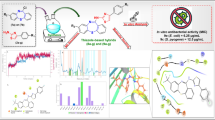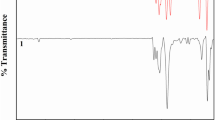Abstract
In this report we are examining how the antioxidant flavonoids can prevent DNA damage and what mechanism of action is involved in the process. Flavonoids are strong antioxidants that prevent DNA damage. The anticancer and antiviral activities of these natural products are implicated in their mechanism of actions. We study the interactions of quercetin (que), kaempferol (kae), and delphinidin (del) with DNA and transfer RNA in aqueous solution at physiological conditions, using constant DNA or RNA concentration 6.25 mmol (phosphate) and various pigment/polynucleotide(phosphate) ratios of 1/65 to 1 (DNA) and 1/48 to 1/8 (tRNA). The structural analysis showed quercetin, kaempferol, and delphinidin intercalate DNA and RNA duplexes with minor external binding to the major or minor groove and the backbone phosphate group with overall binding constants for DNA adducts K que = 7.25 (±0.65) × 104 M−1, K kae = 3.60 (±0.33) × 104 M−1, and K del = 1.66 (±0.25) × 104 M−1 and for tRNA adducts K que = 4.80 (±0.50) × 104 M−1, K kae = 4.65 (±0.45) × 104 M−1, and K del = 9.47 (±0.70) × 104 M−1. The stability of adduct formation is in the order of del>que>kae for tRNA and que>kae>del for DNA. Low flavonoid concentration induces helical stabilization, whereas high pigment content causes helix opening. A partial B to A-DNA transition occurs at high drug concentration, while tRNA remains in A-family structure. The antioxidant activity of flavonoids changes in order delphinidin>quercetin>kaempferol. The results show intercalated flavonoids can make them strong antioxidants to protect DNA from harmful free radical reactions.







Similar content being viewed by others
Abbreviations
- Que:
-
Quercetin
- Del:
-
Delphinidin
- Kae:
-
Kaempferol
- FT-IR:
-
Fourier transform infrared
References
Yanmg, C. S., Lndau, J. M., Huang, M. T., & Newmark, H. L. (2001). Inhibition of carcinogenesis by dietary polyphenolic compounds. Annual Review of Nutrition, 21, 381–406.
Ren, W., Qiao, Z., Wang, H., Zhu, L., & Zhang, L. (2003). Flavonoids: Promising anticancer agents. Medicinal Research Reviews, 23, 519–534.
Middelton, E., Kandaswami, C., & Theoharides, T. C. (2000). The effects of plant flavonoids on mammalian cells: Implications for inflammation, heart disease, and cancer. Pharmacological Reviews, 52, 673–751.
Halliwell, B., Aeschbach, R., Loliger, J., & Arouma. O. I. (1995). Antioxidant characterization. Food and Chemical Toxicology, 33, 617–618.
Fleschin, S., Fleschin, M., Nita, S., Pavel, E., & Magearu, V. (2003). Free radicals mediated protein oxidation in biochemistry. Roun Biotechnology Letters, 5, 479–495.
Ferguson, L. R. (2001). Role of plant polyphenols in genomic stability. Mutation Research, 475, 89–111.
Blackburn, G. M., & Gait, M. J. (1996). Nucleic acids in chemistry and biology, Chap. 8, Oxford University Press.
Sakihama, Y., Cohen, M. F., Grace, S. C., & Yamasaki, H. (2002). Plant phenolic antioxidant and prooxidant acitivities:phenlics-induced oxidative damage mediated by metals in plants. Toxicology, 177, 67–80.
Amic, D., Davidovic, D., Belso, N., & Trinajstic, N. (2003). Structure-radical scavenging activity relationships of flavonoids. Croatica Chemica Acta, 76, 55–61.
Husain, S. R., Cillard, J., & Cillard, P. (1987). Hydroxyl radical scavenging activity of flavonoids. Phytochemistry, 26, 2489–2491.
Jagetia, G. C., Venkatesha, V. A., & Reddy, T. K. (2003). Naringin, a citrus flavonone, protects against radiation-induced chromosome damage in mouse bone marrow. Mutagenesis, 18, 337–343.
Afanas’ev, I. B., Osttachovitch, E. A., Abramova, N. E., Korkina, L. G. (1995). Different antioxidant activities of bioflavonoid rutin in normal and iron-overloading rats. Biochemical Pharmacology, 50, 627–635. .
Win, W., Cao, Z., Peng, X., Trush, M. A., & Li, Y. (2002). Different effects of genistein and resveratrol on oxidative DNA damage in vitro. Mutatation Research, 513, 113–120.
Yoo, K., Guo, Q., & Pacter, L. (2000). Free radical scavenging of red ginseng aqueous extracts. Toxicology, 172, 149–156.
Fiorani, M., De Sancitis, R., De Bellis, R., & Dacha, M. (2002). Intracellular flavonoids as electron donors for extracellular ferricyanide reduction in human erythrocytes. Free Radical Biology & Medicine, 32, 64–72.
Mark, D., Hutchenson, E.R., & Cheng, I. F. (2005). Stability of ferric complexes with 3-hydroxyflavone (Flavonol),5,7-dihydroxyflavone (chrysin) and 3′-4′-dihyroxyflavone. Journal of Agricultural and Food Chemistry, 53, 2953–2960.
Mira, A. L., Fernandes, M. T., Santos, M., Rocha, R., Florenico, M. H., & Jennings, K. R. (2002). Interactions of flavonoids with iron and copper ions: A mechanism for their antioxidant activity. Free Radical Research, 36, 1199–1208.
Jennings, K. R. (2002). Interactions of flavonoids with iron and copper ions: A mechanism for their antioxidant activity. Free Radical Research, 36, 1199–1208.
Thulstrup, P. W., & Thormann, T. (1999). Interaction between ellagic acid and calf thymus DNA studied with flow linear dichroism UV–VIS spectroscopy. Biochemical and Biophysical Research Comunications, 254, 416–421.
Walle, T., Vincent, T. S., & Walle, U. K. (2003). Evidence of covalent binding of the dietary flavonoid quercetin to DNA and protein in human intestinal and hepatic cells. Biochemical Pharmacology, 65, 1603–1610.
Lodovici, M., GuglielmiI, M., & Meoni, P. D. (2001). Effect of natural phenolic acids on DNA oxidation in vitro. Food and Chemical Toxicology, 39, 1205–1210.
Lonneke, C. W., Hollman, C. H., Boots, A. W, & Kleeinjans, J. C. S. (2005). Protection by quercetin and quercetin-rich fruit juice against induction of oxidative DNA damage and formation of BPDE-DNA adducts in human lymphocytes. Mutatation Research, 582, 155–162.
Kanakis, C. D., Tarantilis, P. A., Polissiou, M. G., Diamantoglou, S., & Tajmir-Riahi, H. A. (2005). DNA interaction with naturally occurring antioxidant flavonoids quercetin, kaempferol and delphinidin. Journal of Biomolecular Structure & Dynamics, 22, 719–724.
Kanakis, C. D., Tarantilis, P. A., Polissiou, M. G., & Tajmir-Riahi, H. A. (2006). Interaction of antioxidant flavonoids with tRNA: Intercalation or external binding and comparison with flavonoid-DNA adducts. DNA & Cell Biology, 25, 116–123.
Vijayalakshmi, R., Kanthimathi, M., & Subramanian, V. (2000). DNA cleavage by a chromium (III) complex. Biochemical and Biophysical Research Comunications, 271, 371–734.
Nejedly, K., Chladkova, J., Vorlickova, M., Hrabcova, I., & Kypr, J. (2005). Mapping the B-A conformational transition along plasmid DNA. Nucleic Acids Research, 33(1, e5), 1–8.
Potaman, V. N., Bannikov, Y. A., & Shlyachtenko, L. S. (1980). Sedimentation of DNA in ethanol-water solution within the interval of B to A transition. Nucleic Acids Research, 8, 635–642.
Ahmed Ouameur, A., Malonga, H., Neault, J. F., Diamantoglou, S., & Tajmir-Riahi, H. A. (2004). Taxol interaction with DNA and RNA: Stability and structural features. Canadian Journal of Chemistry, 82, 1112–1118.
Stephanos, J. J. (1996). Drug-protein interactions:Two-site binding of heterocylclic lignads to a monomeric hemogolobin. Journal of Inorganic Biochemistry, 62, 155–169.
Zhong, W., Wang, Y., Yu, J.-S., Liang, Y., Ni, K., & Tu, S. (2004). The interaction of human serum albumin with a novel antidiabetic agent-SU-118. Journal of Pharmaceutical Sciences, 93, 1039–1046.
Dean, J. (2003). Flavone: The molecular and mechanistic study of how a simple flavonoid protects DNA from oxidative damage: Ph.D thesis, East Tennessee State University, USA.
Freifelder, D. (1976). Physical Biochemistry, Chap. 15, W.H. Freeman and Company, New York.
Lambert, J. B., Shurvell, H. F., Lightner, D. A., & Cooks, R. G. (1998). Organic Structural Spectroscopy, Chap. 10–11, Prentice-Hall, Inc., New Jersey.
Taillandier, E., & Liquier, J. (1992). Infrared spectroscopy of DNA. Methods in Enzymology, 211, 307–335.
Ahmed Ouameur, A., & Tajmir-Riahi, H. A. (2004). Structural analysis of DNA interactions with biogenic polyamines and cobalt (III) hexamine studied by Fourier transform infrared and capillary electrophoresis. The Journal of Biological Chemistry, 279, 42041–42054.
Cao, G., Sofic, E., & Prior, R. L. (1997). Antioxidant and antiprooxidant behaviour of flavonids:Structure-activity relationships. Free Radical Biology & Medicine, 22, 749–760.
Wang, H., Cao, G., & Prior, R. L. (1997). Oxygen radical absorbing capacity of anthocyanins. Journal of Agricultural and Food Chemistry, 45, 304–309.
Fukumoto, L. R., & Mazza, G. (2000). Assessing antioxidant and prooxidant activities of phenolic compounds. Journal of Agricultural and Food Chemistry, 48, 3597–3604.
Acknowledgments
We highly appreciate the financial supports from the Natural Sciences and Engineering Research Council of Canada (NSERC), the Agricultural University of Athens and IKY (State Scholarships Foundation of Greece) for this work.
Author information
Authors and Affiliations
Corresponding author
Rights and permissions
About this article
Cite this article
Kanakis, C.D., Tarantilis, P.A., Polissiou, M.G. et al. An Overview of DNA and RNA Bindings to Antioxidant Flavonoids. Cell Biochem Biophys 49, 29–36 (2007). https://doi.org/10.1007/s12013-007-0037-2
Accepted:
Published:
Issue Date:
DOI: https://doi.org/10.1007/s12013-007-0037-2




